In astronomy, stars are classified based on their spectra. Different types of stars (listed below) have different spectral characteristics and, even though they only differ in brightness to the unaided eye, stars are divided into seven basic spectral classes and eight luminosity classes. This division does not include young stellar objects, stellar remnants (white dwarfs, neutron stars) and substellar objects (brown dwarfs).
Spectral types are determined primarily based on the temperature of the stellar photosphere, the outer shell that extends into the stellar surface. The effective temperature of a star depends on the star’s mass – the greater the mass, the hotter the star – and is also linked with the star’s colour. Mass is critical because it is what determines how long the star lives and which evolutionary path it takes. It is closely linked with luminosity. The most massive stars are usually also the most luminous. They appear brighter to the unaided eye from greater distances.
The temperature of a star is estimated based on the star’s ionization state, which is indicated by the presence or absence of particular chemical elements in the stellar spectrum.
The hotter a star is, the rarer it is. More than 76% of stars are cool, M-type stars (red dwarfs), while massive, hot, O-type stars constitute only 0.00003% of all known stars. These hot blue stars are the most short-lived. Due to their high mass, they evolve quickly and their life spans are measured in mere millions of years. In contrast, our Sun is 4.6 billion years old and only about halfway into its lifetime.
The coolest stars appear red because they emit longer wavelengths of visible light, while the hottest ones emit shorter wavelengths and appear blue or bluish-white. Stars emit other colours as well, but they release the most visible light in the so-called “peak wavelength.”
Stellar classification
Each star is assigned a spectral type based on the appearance of its spectrum. Stellar classes typically have three elements: a letter (O-B-A-F-G-K-M), an Arabic number between 0 and 9, and a Roman number between I and VII (or a zero).
The letter indicates the spectral class, which is determined based on the star’s effective temperature. In order of decreasing temperature, the seven main spectral classes in the Morgan-Keenan classification system are: O, B, A, F, G, K, and M. The Arabic number subdivides the class further based on the temperature; 0 indicates the hottest stars in each class, while 9 denotes the coolest. The Roman numeral indicates the luminosity class, classifying stars as main sequence stars, subgiants, giants, bright giants, and supergiants.
The foundation for this classification scheme was created by American astronomer Edward C. Pickering along with Williamina Fleming, and later adapted by Annie Jump Cannon and Antonia Maury. It was published in the Henry Draper Catalogue in the 1920s. The catalogue originally included 225,300 stars.
Pickering conducted a survey of stellar spectra at the Harvard College Observatory in Cambridge, Massachusetts in the 1880s. He continued the work of the late astrophotography pioneer Henry Draper, who had studied astronomy using photography. In 1882, Pickering invented a method of photographing the spectra of multiple stars at the same time. He and his team used the method to take photographs of more than 220,000 stars.
The Harvard spectral classification scheme distinguishes between stars of different temperatures, but does not take into account their luminosity. In other words, it does not distinguish between stars on the main sequence, giants and supergiants. For this reason, the Morgan-Keenan (MK or MKK) system was developed by W. W. Morgan, Philip Childs Keenan, and Edith Marie Kellman at Yerkes Observatory in Wisconsin, and published in 1943. The MKK system, which is still in use today, retained the spectral types used in the Harvard system, but added luminosity classes to indicate whether the star was a dwarf, subgiant, giant, bright giant, or supergiant.
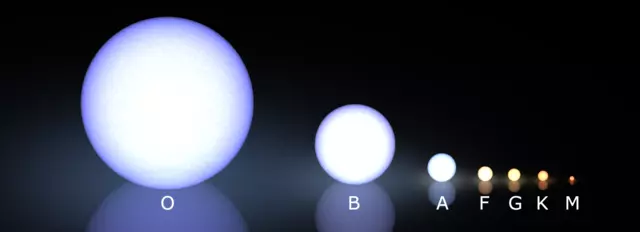
Image depicting the Morgan-Keenan-Kellman spectral classification of main-sequence stars (1943). (CC BY-SA 3.0)
Spectral types: O-B-A-F-G-K-M
OBAFGKM is an acronym for the seven main spectral types of stars. The table below shows the effective temperature range, chromaticity, mass, radius, and luminosity of stars in each class, as well as their average life span.
| Class | Temperature (K) | Chromaticity | Mass (M☉) | Radius (R☉) | Luminosity (L☉) | Life span (years) |
| O | ≥ 30,000 | blue | ≥ 16 | ≥ 6.6 | ≥ 30,000 | 10 million |
| B | 10,000–30,000 | blue-white | 2.1–16 | 1.8–6.6 | 25-30,000 | 100 million |
| A | 7,500–10,000 | white (blue-white) | 1.4–2.1 | 1.4–1.8 | 5–25 | 1 billion |
| F | 6,000–7,500 | white (yellow-white) | 1.04–1.4 | 1.15–1.4 | 1.5–5 | 3 billion |
| G | 5,200–6,000 | yellow | 0.8–1.04 | 0.96–1.15 | 0.6–1.5 | 10 billion |
| K | 3,700–5,200 | orange | 0.45–0.8 | 0.7–0.96 | 0.08–0.6 | 50 billion |
| M | 2,400–3,700 | orange-red | 0.08–0.45 | ≤ 0.7 | ≤ 0.08 | 200 billion |
The table below shows examples of main sequence stars of different spectral types.
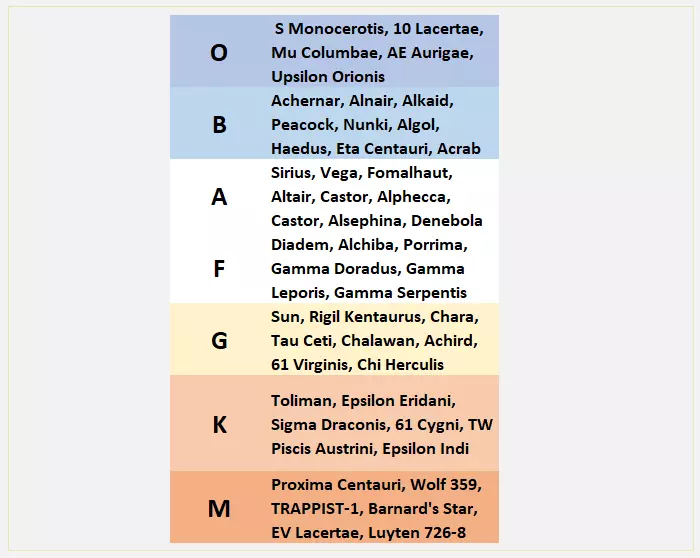
Main sequence stars across different spectral types
Luminosity classes
The Morgan-Keenan system of classifying stellar spectra kept the spectral classes introduced in the Harvard classification system, but added luminosity classes to distinguish between different types of stars. A Roman numeral is used to distinguish between different luminosity classes. These are:
| Luminosity class | Description | Examples |
| 0 or Ia+ | extremely luminous supergiants (hypergiants) | Cygnus OB2-12 (B3-4 Ia+), V382 Carinae (G0-4 Ia+) |
| Ia | luminous supergiants | Deneb (A2 Ia), Rigel (B8 Ia), Alnilam (B0 Ia), Saiph (B0.5 Ia), Wezen (F8 Ia), Aludra (B5 Ia), Mu Cephei (M2 Ia), KY Cygni (M3 Ia) |
| Iab | luminous supergiants (intermediate size) | Alnitak (O9.5 Iab), Sadr (F8 Iab), Mu Normae (O9.7 Iab), Rho Leonis (B1 Iab), Sigma Cygni (B9 Iab), Chi Aurigae (B5 Iab) |
| Ib | less luminous supergiants | Polaris (F7 Ib), Mirfak (F5 Ib), Aspidiske (A9 Ib), Suhail (K4 Ib) |
| II | bright giants | Canopus (A9 II), Adhara (B2 II), Sargas (F0 II), Mintaka (O9.5 II) |
| III | giants | Arcturus (K1.5 III), Aldebaran (K5+ III), Dubhe (K0 III), Capella (G3 III), Hadar (B1 III), Mimosa (B0.5 III), Pollux (K0 III), Avior (K3 III), Miaplacidus (A1 III) |
| IV | subgiants | Regulus (B8 IVn), Shaula (B2 IV), Acrux (B0.5 IV), Alhena (A1 IV), Sabik (A1 IV), Markab (A0 IV), Menkalinan (A1m IV) |
| V | main-sequence stars | Sun (G2 V), Vega (A0 Va), Altair (A7 V), Fomalhaut (A3 V), Spica (B1 V), TRAPPIST-1 (M8 V), Proxima Centauri (M5.5Ve), Epsilon Eridani (K2 V), Barnard’s Star (M4.0 V) |
| VI (or the prefix sd) | subdwarfs | Kapteyn’s Star (sdM1), Groombridge 1830 (Argelander’s Star, G8 VIp) |
| VII (or the prefix D) | white dwarfs | Sirius B (DA), Procyon B (DQZ) |
Some stars fall between luminosity classes. For instance, Alioth, the brightest star in Ursa Major, is between a subgiant and giant, with the classification A1III-IVp, and Atria, the luminary of Triangulum Australe, is between a giant and bright giant (K2 IIb-IIIa). Enif, the brightest star in Pegasus, is between a bright giant and supergiant (K2 Ib-II).
Evolutionary stages
Stars are also divided based on their evolutionary stages, which are similar to luminosity classes. Throughout its life cycle, a star will be a protostar, a pre-main-sequence star, a main sequence star, and possibly a giant or supergiant. Depending on its initial mass, it will end its life as a white dwarf, a neutron star, or a black hole. When they have cooled sufficiently, white dwarfs may become black dwarfs, hypothetical stellar remnants that have not yet been observed because the universe is not old enough for any remnant to reach this stage.
The main sequence is the longest stage in a star’s lifetime and most true stars are main sequence stars, including the Sun. During this stage, stars generate energy in their cores by fusing hydrogen into helium. The energy is carried to the surface and emitted at the photosphere.
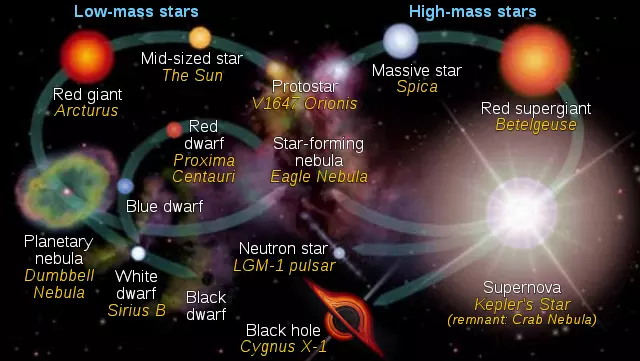
Evolution of low-mass and high-mass stars, credit: Wikimedia Commons/cmglee, NASA Goddard Space Flight Center (CC BY-SA 4.0)
A mass of 0.08 solar masses is generally set as the low limit below which the stellar core does not reach high enough a temperature to ignite hydrogen stably. Objects below this limit are called brown dwarfs. These are substellar objects, or failed stars. However, brown dwarfs are similar to stars in that they burn deuterium in their cores. Low-mass stars also initially burn deuterium.
Stellar masses can be in the range from 0.08 to 150 or more solar masses. The most massive stars known, the Wolf-Rayet stars R136a1 and BAT99-98 in the Large Magellanic Cloud, have estimated masses of 184 – 260 solar masses (R136a1) and around 226 solar masses (BAT99-98). The slash star Westerhout 49-2 in Aquila is another candidate for the most massive star known, with an estimated mass of 90 – 240 solar masses. On the opposite end of the scale, one of the lowest-mass stars known, the red dwarf SCR 1845−6357A in the southern constellation Pavo, has an estimated mass of 0.07 solar masses.
Stellar mass
The life cycle of a star is determined primarily by the star’s mass. The more massive a star is, the faster it will burn through its supply of hydrogen fuel. When hydrogen fusion stops, the star evolves away from the main sequence to become a giant. Astronomers divide stars into several groups based on mass:
- very low-mass stars (< 0.5 solar masses)
- low-mass stars (0.5 to 1.8 – 2.5 M☉)
- intermediate-mass stars (1.8-2.5 M☉ to 5-10 M☉)
- massive stars (> 7-10 M☉)
Very low-mass stars never become red giants. Once they have depleted their supply of hydrogen, they become helium white dwarfs and gradually cool. Low-mass stars do evolve into red giants when they exhaust the hydrogen in their cores. They end their lives by ejecting their outer shells as planetary nebulae, leaving behind white dwarfs. This will be the fate of the Sun in about 5 billion years. Intermediate-mass stars have a similar evolutionary path to low-mass stars. Massive stars evolve into supergiants and usually end their lives as supernovae.
Hertzsprung-Russell diagram
The Hertzsprung-Russell diagram (HR diagram) is a diagram that shows the relationship between the stars’ luminosities (absolute magnitudes) and their effective temperatures or spectral classes. It was named after the Danish astronomer Ejnar Hertzsprung and American astronomer Henry Norris Russell, who created it independently in the 1910s.
HR diagrams can take several forms, but they all share the same basic layout. Stars with greater luminosity are placed at the top of the diagram and those with higher surface temperatures are on the left side. The diagram shows stars at different stages of their evolutionary cycle. Most stars are in the region of the main sequence, which stretches from the upper left for hot, luminous stars to the bottom right for cool stars. Red giants and supergiants have low temperatures and high luminosities, so they are found in the region above the main sequence. White dwarfs occupy the bottom left region of the HR diagram, as they have high temperatures but low luminosities.
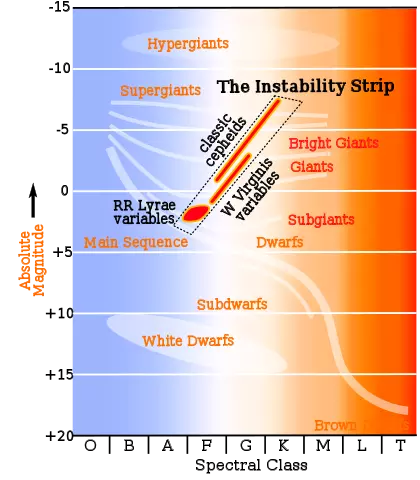
Hertzsprung-Russell diagram, credit: Wikimedia Commons/Rursus (CC BY-SA 3.0)
Since a star’s surface temperature and luminosity change as the star goes through different evolutionary stages, the HR diagram is a useful tool for the study of stellar evolution. Astronomers can tell a star’s evolutionary stage by determining its place in the diagram.
The HR diagram can also be used to estimate distances of galaxies and star clusters. Astronomers do this by comparing the apparent magnitudes of the stars in the galaxy or cluster to the absolute magnitudes of stars whose distances are known.
Star types
These are the different types of stars based on spectral type, luminosity class and stage of evolution:
1. Young stellar objects (YSOs)
- Protostars
- Pre-main-sequence stars (T Tauri stars and Herbig Ae/Be stars)
Young stellar objects are stars in an early stage of evolution, one that precedes the main sequence. They can be protostars or pre-main-sequence stars. They are divided into classes 0, I, II and III based on how much infrared radiation they emit.
Class 0 objects are only a few thousand years old and have not yet started undergoing nuclear fusion at their cores. They are fueled solely by gravitational potential energy which is released as they accrete infalling material.
Class I protostars still collect the dust and gas from the surrounding clouds and their luminosity is largely dependent on gravitational energy. However, unlike class 0 objects, they have begun to undergo nuclear fusion in their centres. These stars are invisible at optical wavelengths and can only be detected at infrared and radio wavelengths because they are still embedded in thick clouds of dust and gas.
Class II objects are still shrouded in disks of dust and gas, but the process of accumulating infalling material has mostly finished. These objects are also known as classical T Tauri stars.
Class III objects have lost their disks and roughly correspond to weak-line T Tauri stars.
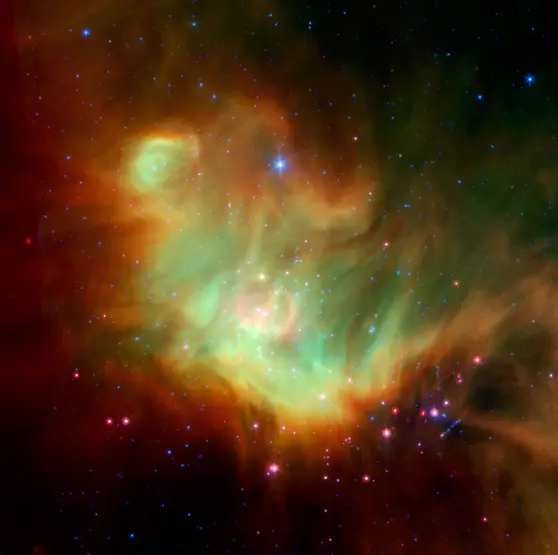
Protostar LRLL 54361 in the star-forming region IC 348. Credit: NASA, ESA, J. Muzerolle (STScI), E. Furlan (NOAO and Caltech), K. Flaherty (University of Arizona/Steward Observatory), Z. Balog (Max Planck Institute for Astronomy), and R. Gutermuth (University of Massachusetts, Amherst)
Protostars
Protostars are newly formed stars that are still gathering material from the surrounding molecular cloud. They are formed when a fragment of the parent molecular cloud collapses under the force of its own gravity and a core forms within the fragment. This stage lasts until the infalling material is depleted and stars become visible as pre-main-sequence stars.
Stars are formed within dense cores, small molecular clouds that are initially in balance between the force of self-gravity and both gas pressure and magnetic pressure. As these clouds gather material from the surrounding cloud, they become more massive, and the force of gravity overwhelms pressure. As a result, the dense core begins to collapse. The gas that collapses toward the centre of the core first creates a small protostar and then a protoplanetary disk around it.
Protostars can be exceptionally massive. In 2016, a team of scientists discovered a young stellar object with a mass more than 30 times the mass of the Sun. The protostar, designated G11.92–0.61 MM1 (or simply MM1) lies approximately 11,000 light years away and is still in the process of gathering dust and gas from its parent molecular cloud. It will be even more massive when it reaches the main sequence.
Another high-mass protostar, designated G45.47+0.05, was detected in 2020. It has an estimated mass 30 to 50 times that of the Sun. Like MM1, it is still in the process of growing.
Pre-main-sequence stars
Once stellar winds have dissipated the surrounding clouds of dust and gas, stars become visible as pre-main-sequence objects. At this stage, stars have accumulated almost all their mass, but have not yet begun to burn hydrogen in their cores. They contract and their internal temperature increases until they start the nuclear fusion of hydrogen on the zero-age main sequence. The period when the stars contract is known as the pre-main-sequence stage. During this stage, stars are fueled by gravitational contraction. In the early stage, most of them have circumstellar disks where planets may form.
Pre-main-sequence stars can be either T Tauri stars of Herbig Ae/Be stars, depending on their mass. T Tauri stars have masses of up to 2 solar masses, and Herbig Ae/Be stars are in the range between 2 and 8 solar masses. Stars will a higher initial mass do not have a pre-main-sequence stage; by the time they are visible, they are already burning hydrogen and are on the main sequence.
T Tauri stars
T Tauri stars are very young variable stars that are still contracting to the main sequence. They are typically found near molecular clouds. This class includes the youngest visible stars of the spectral types F, G, K and M with masses of up to 2 solar masses. These stars are less than 10 million years old. About half of them have protoplanetary disks which eventually dissipate. Their effective temperatures are comparable to those of main sequence stars with the same mass, but T Tauri stars are more luminous because they are larger. They are fueled by gravitational energy and do not fuse hydrogen in their cores because their central temperatures are not high enough. They take about 100 million years to reach the main sequence stage.
T Tauri stars were named after T Tauri, a young star discovered by the English astronomer John Russell Hind in October 1852. The star illuminates the nebula NGC 1555, also known as Hind’s Variable Nebula. The nebula varies in brightness because its central star is variable. It is a Herbig-Haro object, a bright nebulous patch associated with a very young star. T Tauri is believed to be only 0.4 million years old. It appears in the same area of the sky as the Hyades cluster, not far from Ain (Epsilon Tauri), the star that marks the Bull’s northern eye.
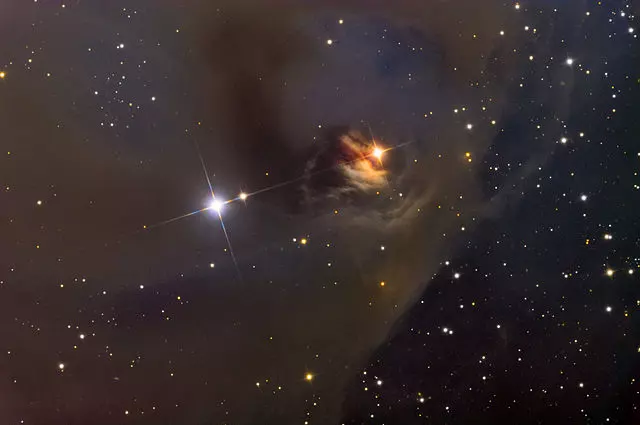
T Tauri and Hubble’s Variable Nebula (NGC 1555), credit: Adam Block/Mount Lemmon SkyCenter/University of Arizona (CC BY-SA 3.0 US)
Herbig Ae/Be stars
Herbig Ae/Be stars are pre-main-sequence stars of the spectral types A or B with masses between 2 and 8 times that of the Sun. Like T Tauri stars, they are very young – up to 10 million years old – and still in the process of contracting. They are shrouded in dust and gas and sometimes have circumstellar disks. They can vary in brightness due to planetesimals in the circumstellar disks.
Herbig Ae/Be stars were named after the American astronomer George Herbig, who was the first to identify them in 1960.
2. Main sequence stars
Main sequence stars, or dwarfs, are stars that generate energy through nuclear fusion of hydrogen into helium in their cores. They are the most numerous stars in the universe (not including substellar objects). The energy that they generate in the core is carried to the surface and radiated away at the photosphere.
The main sequence is the longest stage in a star’s lifetime. For low-mass stars like the Sun, it lasts about 10 billion years. The more massive a star is, the less time it spends on the main sequence. The most massive stars spend only a few million years at this stage. They consume the hydrogen in their cores faster and evolve into supergiants.
Depending on their surface temperature, dwarf stars can belong to one of the following classes:
- O-type dwarfs: S Monocerotis, AE Aurigae, Mu Columbae
- B-type dwarfs: Achernar, Alkaid, Algol
- A-type dwarfs: Sirius, Vega, Fomalhaut
- F-type dwarfs: Diadem, Alchiba, Zavijava
- G-type dwarfs: Sun, Alpha Centauri A, Tau Ceti
- K-type dwarfs: Alpha Centauri B, Epsilon Eridani, 61 Cygni
- M-type dwarfs: Proxima Centauri, Barnard’s Star, TRAPPIST-1
O-type stars
O-type main sequence stars are the hottest stars in the known universe. They make up only 0.00003% of all main sequence stars. With effective temperatures of at least 30,000 K, they are at least 30,000 times more luminous than the Sun. They can be as much as a million times more luminous than our star.
Hot blue O-type stars are very rare. It is believed that there are only up to 20,000 of them in our galaxy. They are commonly found in active star forming regions, such as arms of spiral galaxies or in interacting galaxies. They are often components of multiple star systems.
These stars are exceptionally massive. They have masses at least 16 times that of the Sun and radii at least 6.6 times the Sun’s. Due to their high mass, the stars evolve very quickly and have the shortest life spans of all spectral classes. They live only about 10 million years before going out as supernovae.
Notable examples in this class include the irregular variable star S Monocerotis in the Christmas Tree Cluster (NGC 2264) in Monoceros, AE Aurigae in the Flaming Star Nebula (IC 405) in Auriga, Theta1 Orionis C in the Trapezium Cluster in Orion, Upsilon Orionis in Orion, and Mu Columbae in Columba. All these stars are supernova candidates, with masses in the range from 16 solar masses (Mu Columbae) to 33 solar masses (Theta1 Orionis C).
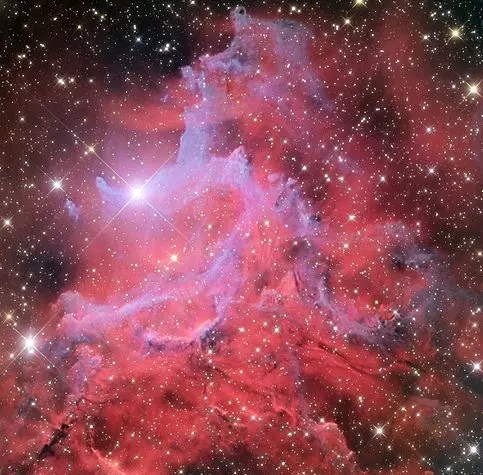
AE Aurigae and the Flaming Star Nebula (IC 405), credit: Adam Block/Mount Lemmon SkyCenter/University of Arizona (CC BY-SA 3.0 US)
B-type stars
B-type main sequence stars are also exceptionally hot and luminous, but have more modest parameters than O-type stars. They have temperatures in the range from 10,000 to 30,000 K and are between 25 and 30,000 times more luminous than the Sun. Their masses are typically in the range from 2.1 to 16 solar masses, and their sizes between 1.8 and 6.6 solar radii. These stars constitute only 0.13% of all stars on the main sequence.
Examples in this class include Achernar in Eridanus, the ninth brightest star in the sky, with the stellar classification B6 Vep, Alkaid in Ursa Major (B3 V), Alnair in Grus (B6 V), Peacock in Pavo (B3 V), Nunki in Sagittarius (B2.5 V), Eta Centauri in Centaurus (B1.5 Vne), and the famous variable star Algol in Perseus (B8 V).
A-type stars
A-type stars have surface temperatures between 7,600 and 10,000 K and appear white or bluish-white in colour. They typically have masses in the range from 1.4 to 2.1 solar masses and radii between 1.4 and 1.8 times that of the Sun while on the main sequence. Their bolometric luminosity is between 5 and 25 times that of the Sun.
These stars make up 0.6% of all main sequence stars. They are not as rare and O- and B-type stars, but also not as common as cooler types. Several first-magnitude stars belong to this spectral class: Sirius, Vega, Altair, and Fomalhaut. These stars lie in the solar neighbourhood. Sirius is the fifth nearest star system to the Sun at a distance of 8.709 light years. Vega lies 25.04 light years away, Altair is slightly closer at 16.73 light years, and Fomalhaut is roughly at the same distance as Vega, 25.13 light years away.
S5-HVS1, the fastest moving star detected as of November 2019, is also classified as an A-type dwarf. It is believed to be travelling at 1,755 km/s.
F-type stars
F-type stars comprise 3% of all main sequence stars. With effective temperatures between 6,000 and 7,500 K, they appear white or yellow-white in colour. They are slightly larger and more massive than Sun-like stars. They typically have masses in the range between 1.04 and 1.4 solar masses and radii between 1.15 and 1.4 times that of the Sun. They are between 1.5 and 5 times more luminous than the Sun.
Notable examples of this class are Diadem in Coma Berenices (F5 V), Alchiba in Corvus (F1 V), Zavijava in Virgo (F9 V), Porrima in Virgo (F0 V), and Upsilon Andromedae (F8 V) in Andromeda.
G-type stars
G-type stars – yellow dwarfs – comprise 7.6% of all main sequence stars. They have masses in the range from 0.8 to 1.04 solar masses and radii between 0.96 and 1.15 solar radii. Their luminosity is in the range from 0.6 to 1.5 times that of the Sun with surface temperatures between 5,200 and 6,000 K. These stars spend about 10 billion years on the main sequence before evolving into subgiants and then red giants. As they keep expanding, their gravity becomes insufficient to hold their outer layers and they lose a lot of mass. The expelled material forms a planetary nebula, and the remnant core of the star becomes a dense white dwarf.
The Sun and two its close neighbours – Rigil Kentaurus (Alpha Centauri A) and Tau Ceti belong to this class. The Sun is a yellow dwarf with the stellar classification G2V and an effective temperature of 5,772 K. Rigil Kentaurus is the primary component of the nearest star system to the Sun. Located only 4.37 light years away, the star is slightly larger and more massive than the Sun, with a mass of 1.100 solar masses and a radius 1.2234 times solar. With a surface temperature of 5,790 K, it is 1.519 times more luminous than the Sun. It has the same spectral type as the Sun, G2V.
Tau Ceti is older than the Sun, with an estimated age of 5.8 billion years. It is smaller and less massive than our star, with 78% of the Sun’s mass and 79% its radius. It has the stellar classification G8V. It hosts at least four planets, two of which may be in the habitable zone. Tau Ceti lies only 11.912 light years away.
K-type stars
K-type stars – orange dwarfs – make up 12.1% of all main sequence stars. With surface temperatures between 3,700 and 5,200 K, they shine with 0.08 to 0.6 solar luminosities and appear orange in colour. They have masses in the range from 0.45 to 0.8 solar masses and radii between 70% and 96% that of the Sun.
The nearby examples of this class include Toliman (Alpha Centauri B), Ran (Epsilon Eridani), and 61 Cygni. Toliman is an orange dwarf of the spectral type K1V located only 4.37 light years away. It is the secondary component of the nearest star system to the Sun. Epsilon Eridani is the third nearest star to the Sun that is visible to the unaided eye. It shines at magnitude 3.736 from a distance of 10.475 light years. It has the stellar classification K2V. 61 Cygni is a binary system composed of two orange dwarfs of the spectral types K5V and K7V. The system lies 11.404 light years away. 61 Cygni A is a BY Draconis-type variable, a star that varies in brightness due to starspots. It shines at magnitude 5.21. 61 Cygni B is a flare star with an apparent magnitude of 6.05. The stars are about 6.1 billion years old. They orbit each other with a period of 678 years.
M-type stars
M-type main sequence stars, also known as red dwarfs, are the most numerous stars in the universe. They make up 76.45% of all main sequence stars. They are the smallest and least massive of all the stars on the main sequence, with masses between 0.08 and 0.45 solar masses and radii of up to 0.7 solar radii. Red dwarf stars shine with up to 8% of the Sun’s luminosity with surface temperatures between 2,400 and 3,700 K. They appear reddish or orange-red in colour.
Proxima Centauri, the nearest individual star to the Sun, is a red dwarf of the spectral type M5.5Ve. It lies only 4.2465 light years away. It is the faintest component of the Alpha Centauri system. The star has a mass of only 0.1221 solar masses and shines with 0.0017 solar luminosities. It is classified as a flare star. With an apparent magnitude that varies between 10.43 and 11.11, it is invisible to the unaided eye. It hosts three confirmed exoplanets, designated Proxima Centauri b, c, and d.
Barnard’s Star, the fourth individual nearest star to the Sun (after the three components of the Alpha Centauri system), is another example of this spectral class. Classified as an M4.0 dwarf, it lies 5.9629 light years away and shines at magnitude 9.511.
TRAPPIST-1, a class M8 red dwarf, gained attention in 2016 and 2017, when seven planets were discovered orbiting it. Three of the planets are believed to be in the habitable zone. The star lies 40.54 light years away. It has a mass of about 0.898 solar masses and a radius of only 0.1192 solar radii. Its estimated age is about 7.6 billion years.
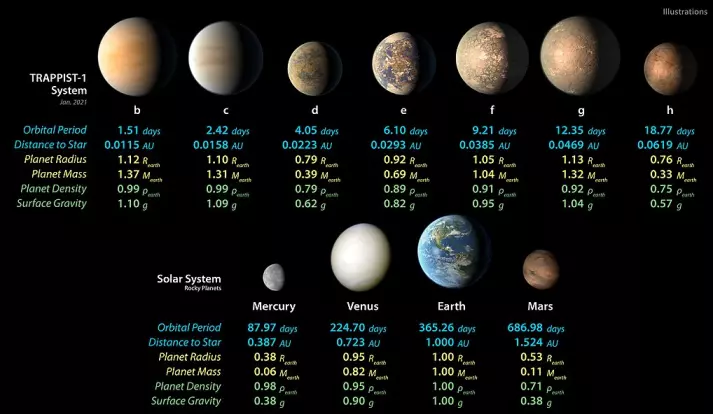
Detailed measurements of the physical properties of the seven rocky TRAPPIST-1 planets and the four terrestrial planets in our solar system help scientists find similarities and differences between the two planet families. Credit: NASA/JPL-Caltech
3. Subgiants
Subgiants are stars that are brighter than main sequence stars of the same spectral type, but not quite as bright as giants. This definition applies to subgiants as a luminosity class. The term subgiant is also used for an evolutionary stage of low to intermediate mass stars. During this stage, the stars have exhausted the hydrogen in their cores and the hydrogen shells around the cores continue to fuse, without any major visible changes to the exteriors.
Stars that are on the evolutionary subgiant branch do not always have the subgiant spectral type. They can be classified as giants. Similarly, stars may have the spectral class of a subgiant even if they are at a very different stage of evolution. For instance, the star Theta1 Orionis E in the Trapezium Cluster in the Orion Nebula is classified as a yellow subgiant of the spectral type G2 IV even though it is only 500 million years old and not even on the main sequence yet. Evolutionary subgiants are identified by their lithium abundance or strength of coronal emission.
In terms of luminosity, subgiants typically have the stellar classification B, A, F or G. O-type stars, M-type stars, and class K stars cooler than K1 are normally not given subgiant luminosity classes.
There are, however, exceptions to this rule. Zeta Ophiuchi has the stellar classification O9.2IVnn, indicating a hot blue subgiant. It lies 366 light years away and shines at magnitude 2.569. With a mass 20.2 times that of the Sun, the star is a supernova candidate and will meet its end in a few million years even though it is only about 3 million years old. It is 74,100 times more luminous than the Sun and has an effective temperature of 34,000 K. It is sometimes classified as a main sequence star of the spectral type O9.5 V.
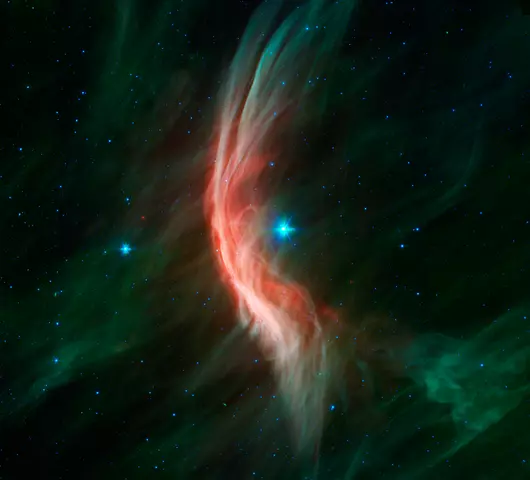
Zeta Ophiuchi is a young, large and hot star located around 370 light-years away. It dwarfs our own sun in many ways — it is about six times hotter, eight times wider, 20 times more massive, and about 80,000 times as bright. Even at its great distance, it would be one of the brightest stars in the sky were it not largely obscured by foreground dust clouds. This massive star is travelling at a snappy pace of about 54,000 mph (24 kilometers per second), fast enough to break the sound barrier in the surrounding interstellar material. Because of this motion, it creates a spectacular bow shock ahead of its direction of travel (to the left). The structure is analogous to the ripples that precede the bow of a ship as it moves through the water, or the sonic boom of an airplane hitting supersonic speeds. The fine filaments of dust surrounding the star glow primarily at shorter infrared wavelengths, rendered here in green. The area of the shock pops out dramatically at longer infrared wavelengths, creating the red highlights. Credit: NASA/JPL-Caltech
Here are some examples of stars with subgiant luminosity classes:
- O-type subgiants: Zeta Ophiuchi, HD 93250
- B-type subgiants: Acrux, Regulus, Shaula
- A-type subgiants: Menkalinan, Alhena, Merak
- F-type subgiants: Wasat, Theta Ursae Majoris, Zeta Herculis
- G-type subgiants: Alshain, Muphrid, Mu Herculis
- K-type subgiants: Eta Cephei, Delta Eridani
4. Giants
Giants are stars that have exhausted the supply of hydrogen in their cores and evolved away from the main sequence. They have considerably higher luminosity and larger radii than main sequence stars with the same surface temperature. Their radii can be up to a few hundred times that of the Sun and their luminosities are in the range between 10 and a few thousand times the Sun’s.
Not all stars become giants. Very low mass stars (< 0.5 M☉) become helium white dwarfs once they exhaust their hydrogen. Due to their low mass, they never become hot enough to fuse helium in their cores. Massive stars with masses of at least 7 to 10 M☉ evolve into supergiants when they burn through their supply of hydrogen. Stars with masses above 12 M☉ on the main sequence briefly evolve into blue giants before becoming blue supergiants. Their spectral features may present as those of giants or supergiants even before the stars have stopped burning hydrogen.
Low and intermediate mass stars do evolve into red giants once they have depleted the hydrogen in their cores. Low-mass stars (0.5 to 1.8-2.5 M☉) like the Sun start to burn helium in a helium flash, a short thermal runaway nuclear fusion of helium into carbon. The Sun will experience a flash about 1.2 billion years after it evolves away from the main sequence. It will spend about 10% of its life on the red giant branch.
Intermediate-mass stars (1.8-2.5 M☉ to 5-10 M☉) spend a short time on the red giant branch before igniting helium without a flash.
Here are some examples of giants of different spectral types:
- O-type giants: Meissa, Hatysa, Menkib
- B-type giants: Hadar, Mimosa, Elnath
- A-type giants: Miaplacidus, Alioth, Rasalhague
- F-type giants: Caph, Adhafera, Alkarab
- G-type giants: Capella, Nekkar, Kappa Geminorum
- K-type giants: Arcturus, Aldebaran, Pollux
- M-type giants: Gacrux, Mirach, Mira
Giants are commonly referred to by their colour, which roughly corresponds to their temperature and spectral class.
Red giants
Red giants are giant stars of the spectral types M, K, C (carbon stars) and S (S-type stars). The brightest red giant is Arcturus, the fourth brightest star in the sky. Some stars of the spectral type G can also be called red giants. Yed Posterior (Epsilon Ophiuchi) is one of these, with the stellar classification G9.5 IIIb.
Red giant stars are low to intermediate-mass stars that have reached a late stage in their evolution. They typically have masses in the range from 0.3 to 8 solar masses and temperatures lower than 5,000 K.
These stars can be at several different stages of their evolutionary cycle:
- the red-giant branch (RGB)
- the red horizontal branch (red clump)
- the asymptotic giant branch (AGB)
RGB stars are the most common of the three. These are giants that are still fusing hydrogen into helium in a shell around a helium core. Aldebaran, Arcturus and Gacrux belong to this group. Red clump giants (Hamal, Kappa Persei, Delta Andromedae) are fusing helium into carbon in their cores, while stars on the asymptotic giant branch (Mira, Rasalgethi, Chi Cygni) burn helium in a shell around a degenerate carbon-oxygen core and have a hydrogen-burning shell beyond the helium-burning one.
Carbon stars
Carbon stars are stars on the asymptotic giant branch whose atmospheres have more carbon than oxygen. These stars appear strikingly red. Classical carbon stars are giants, but there are also dwarf and supergiant carbon stars.
Examples of this class include Hind’s Crimson Star (R Leporis), S Camelopardalis, CW Leonis, and La Superba (Y Canum Venaticorum).
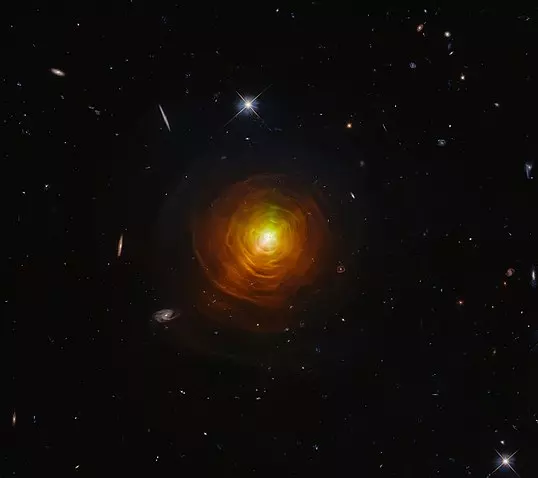
The carbon star CW Leonis, image: ESA/Hubble & NASA, T. Ueta, H. Kim (CC BY 4.0)
S-type stars
S-type stars are cool giants with equal amounts of carbon and oxygen in their atmospheres. Their spectra also show bands of zirconium monoxide (ZrO). Intrinsic S-type stars are typically in the most luminous phase of the asymptotic giant branch, which lasts less than a million years. They can be long period variables. These stars are quite rare. They make up less than 10% of AGB stars. Extrinsic class S stars are normally less luminous and classified as semiregular or irregular variables. They form an even smaller percentage of AGB giants.
Examples of this class include the Mira variables R Andromedae, W Aquilae, R Cygni, R Geminorum, BH Crucis, and Chi Cygni.
Orange giants
Giant stars of the spectral type K are sometimes called orange giants to distinguish them from class M red giants. The first-magnitude red giants Arcturus, Aldebaran and Pollux are all class K stars. They are smaller and less luminous than M-type giants, and they have warmer atmospheres.
Yellow giants
Yellow giants are giant stars of the spectral types G, F and sometimes A. They are not as common as red giants because they spend less time at this stage and only evolve from slightly more massive stars. In terms of evolutionary cycle, they may be stars evolving toward the RGB phase or stars at a later evolutionary stage on the horizontal branch. The latter have more heavy elements and a lower mass, and they are generally unstable. They include many pulsating variable stars classified as classical Cepheids, Delta Scuti variables, RR Lyrae variables, and W Virginis variables.
Blue giants
Blue giants are giant stars of the spectral types O and B. Some early A-type stars may also be called blue giants. These stars are far less common than red giants because they only evolve from more massive stars and because the blue giant stage is very brief. Blue giant stars have initial masses of at least 2 solar masses. With radii between 5 – 10 times that of the Sun, they are not as large as red giants. Because they do not live very long, these stars are often found in OB associations, young stellar associations consisting of stars formed inside the same molecular cloud.
Blue giants can be anything from massive, luminous stars ending their main sequence lifetime to low-mass stars on the horizontal branch. The high-mass stars first evolve into blue giants, then into bright blue giants, and finally into blue supergiants before becoming red supergiants. Stars with the highest masses barely have a giant stage. The stage is very brief, and the stars soon become supergiants.
The lower-mass stars on the horizontal branch evolve back to asymptotic giant branch (AGB) stars. They can become blue giants depending on mass and metallicity.
White giants
Some class A stars may be called white giants. Thuban in the constellation Draco is an example of this. It is a giant of the spectral type A0III.
5. Bright giants
Bright giants are stars that are a bit larger and more luminous than regular giants, but not quite as luminous as supergiants. The examples of this luminosity class include:
- O-type bright giants: Mintaka, 63 Ophiuchi, Tau Canis Majoris
- B-type bright giants: Adhara, Muliphein, HD 33203
- A-type bright giants: Canopus, N Carinae, Omicron Scorpii
- F-type bright giants: Sargas, Turais, Albaldah
- G-type bright giants: Delta Trianguli Australis, V723 Monocerotis, V415 Carinae
- K-type bright giants: Almach, Dabih, Hassaleh, Saclateni
- M-type bright giants: CQ Camelopardalis, Delta Sagittae, Delta2 Lyrae
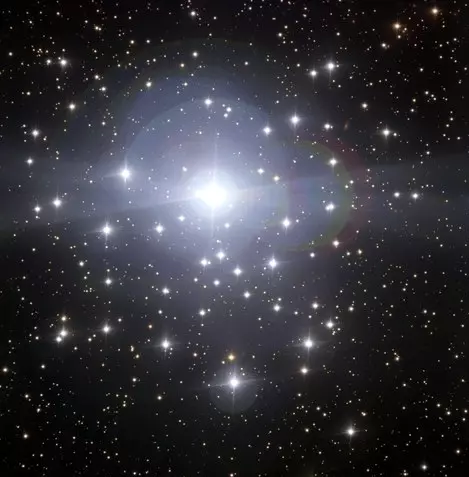
The O-type bright giant Tau Canis Majoris is the brightest member of the open cluster NGC 2362 (the Tau Canis Majoris Cluster). Image: ESO (CC BY 4.0)
6. Supergiants
Supergiants are the most luminous stars of different spectral classes. They have absolute magnitudes between -3 and -8. Their temperatures range from 3,400 K for cool, red supergiants to more than 20,000 K for blue supergiants. Supergiants have more heavy elements in their spectra than main sequence stars and are larger than giants of the same spectral type. Red, M-type supergiants are older, more evolved stars, while O- and B-type supergiants are only a few million years old and have evolved quickly due to their high masses.
The Morgan-Keenan classification system makes a distinction between four luminosity classes of supergiants:
- less luminous supergiants (Ib)
- intermediate luminosity supergiants (Iab)
- luminous supergiants (Ia)
- hypergiants (0 or Ia+)
Supergiants are not just a luminosity class, but also represent an evolutionary stage in the life of stars with masses of more than 8 – 10 solar masses. When they exhaust the hydrogen in their cores, these stars quickly start to fuse helium. Once they have exhausted the helium, they continue to fuse heavier elements until they develop an iron core. When this happens, the core rapidly collapses, triggering a Type II supernova.
Stars do not have to be evolutionary supergiants to be classified as supergiants. Evolved stars with spectral features and luminosities similar to those of supergiants can be assigned a supergiant luminosity class. These are mostly red giants on the asymptotic giant branch (AGB) and post-AGB stars. For example, the variable post-AGB star RV Tauri is classified as a bright supergiant (G2eIa-M2Ia), even though it has only 53% of the Sun’s mass.
Here are some examples of supergiants across different spectral classes:
- O-type supergiants: Alnitak, Naos, Alpha Camelopardalis
- B-type supergiants: Rigel, Alnilam, Saiph, Aludra
- A-type supergiants: Deneb, Aspidiske, Eta Leonis
- F-type supergiants: Mirfak, Wezen, Polaris, Sadr, Arneb
- G-type supergiants: Mu Persei, Sadalsuud, Sadalmelik, Mebsuta
- K-type supergiants: Suhail, BG Geminorum, Zeta Cephei
- M-type supergiants: Betelgeuse, Antares, Mu Cephei
Supergiants are found in all the main spectral classes, but most of them are spectral type B. There are more B-type supergiants than those of all other spectral types combined.
Supergiants are generally not cooler than mid-M class at about 3,400 K. Stars cooler than this would be highly unstable. There are, however, exceptions. The luminous red supergiant VX Sagittarii has a temperature of 2,900 K at visual minimum and 3,200 to 3,400 K near maximum. It is classified as a pulsating variable and has an uncommonly high magnitude range.
Like giant stars, supergiants can be referred to by their colour instead of their spectral class.
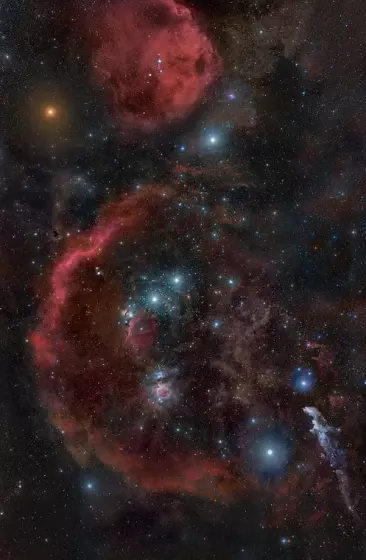
The supergiants of Orion: Betelgeuse (top left), Rigel (bottom right), Saiph (bottom left), Alnitak and Alnilam (the left and central stars of Orion’s Belt), credit: Rogelio Bernal Andreo (CC BY-SA 3.0)
Blue supergiants
Blue supergiants are hot, luminous stars of the spectral types O and B. They are sometimes also called OB supergiants. They have surface temperatures between 10,000 and 50,000 K and are at least 10,000 times more luminous than the Sun. For example, the O-type supergiants Alnitak and Naos shine with 250,000 and 813,000 solar luminosities, while their B-type counterparts Alnilam and Rigel have an energy output 537,000 and 120,000 times that of the Sun. The most luminous blue supergiants can be a million times more luminous than the Sun.
Blue supergiants evolve from stars with initial masses of about 10 – 300 solar masses. Because they are exceptionally massive, these stars spend only a few million years on the main sequence. When they become supergiants, they are generally unstable, experiencing a high degree of mass loss. Some of these stars become luminous blue variables (LBVs) and experience episodes of exceptionally high mass loss. Blue supergiants with lower masses continue to expand in size until they evolve into red supergiants. As they grow, they spend some time as yellow supergiants.
Yellow supergiants
Yellow supergiants are supergiant stars of spectral type F or G, with surface temperatures from about 4,000 K to 7,000 K. Some late A of early K-type stars can also be yellow supergiants. These are rare stars and can be found at different evolutionary stages.
Yellow supergiants are much larger than the Sun. Their radii are in the range from 30 to several hundred times that of the Sun. They are typically at least 1,000 times more luminous than the Sun. The most luminous yellow supergiants can exceed 100,000 solar luminosities.
Even though these stars are quite large, they are not necessarily very massive. They can be less massive than the Sun or they can have more than 20 solar masses. Low-mass yellow supergiants have very low surface gravities.
Spectral standards for the yellow supergiant class include Arneb (Alpha Leporis), Mirfak (Alpha Persei), Wezen (Delta Canis Majoris), Mu Persei, Sadalmelik (Alpha Aquarii), and Mebsuta (Epsilon Geminorum).
Many yellow supergiants are variable stars, primarily Cepheid variables. These stars pulsate radially, and their diameter and temperature vary with the pulsations. Because there is a direct relationship between their pulsation period and luminosity, Cepheids are used as standard candles for establishing galactic and extragalactic distances. Stars classified as classical Cepheids include Polaris (F7Ib), Eta Aquilae (F6 Iab), Mekbuda (F7Ib to G3Ib), RT Aurigae (F8Ib), and Delta Cephei (F5Ib-G1Ib), the prototype for this class.
White supergiants
White supergiants are a rare class of supergiant stars of spectral type A to early F. The brightest example of this class is Deneb (Alpha Cygni), a supergiant of the spectral type A2 Iae. The star has a mass 19 times that of the Sun and a radius 203 times solar. With an effective temperature of 8,525 K, it is about 196,000 times more luminous than the Sun. It shines at magnitude 1.25 from an approximate distance of 2,615 light years. It is by far the most distant first-magnitude star. Other bright examples of this class include Eta Leonis (A0 Ib), Aspidiske (Iota Carinae, A9 Ib), and Omicron2 Centauri (A2 Iae).
Orange supergiants
Some early or hotter class K supergiants are sometimes referred to as orange supergiants. These stars are very rare compared to M-type supergiants because they are in a very brief transition stage. This class includes Zeta Cephei (K1.5 Ib), Suhail (Lambda Velorum, K4 Ib), and BG Geminorum (K0I).
Red supergiants
Red supergiants are supergiant stars of spectral types K and M. They develop from main sequence stars with masses between 8 and 30 times that of the Sun. Due to their high mass, they are normally no more than about 25 million years old. The best-known red supergiants in the sky are the two brightest ones: Betelgeuse in the constellation Orion and Antares in Scorpius.
The largest known stars – Stephenson 2-18, UY Scuti, and VY Canis Majoris, among others – belong to this group. These are the coolest and largest supergiant stars. They have surface temperatures below 4,100 K and are usually at least several hundred times larger than the Sun. Even though they are the largest stars in terms of volume, they are not the most massive. Their masses are typically in the range from about 10 to 40 solar masses.
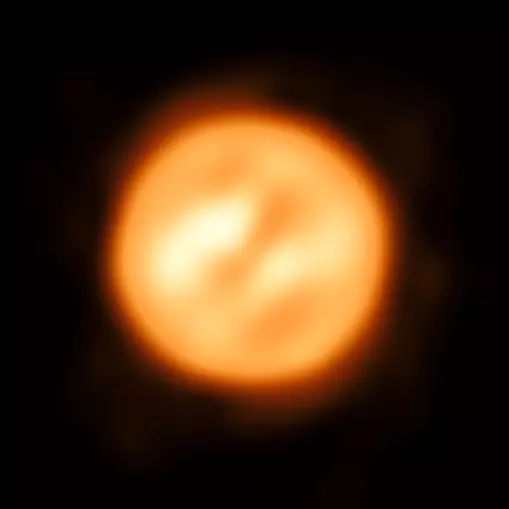
Using ESO’s Very Large Telescope Interferometer astronomers have constructed this remarkable image of the red supergiant star Antares. This is the most detailed image ever of this object, or any other star apart from the Sun. ESO/K. Ohnaka (CC BY 4.0)
Red supergiants undergo high mass loss through powerful stellar winds. The lost material forms visible nebulae around the stars. By the time they reach the end of their life cycle, red supergiants have lost a substantial portion of their initial mass. By the time their cores collapse, they have typically reached a mass 10 times that of the Sun.
Even though they are much cooler than the Sun, the sheer size of these stars makes them tens or hundreds of thousands of times more luminous than our star. The theoretical upper limit to the radius of a red supergiant is set at about 1,500 solar radii. Stars above this limit are believed to be too unstable. However, the estimated radii of the largest known stars exceed this value. UY Scuti is reported to have a radius 1,708 times that of the Sun and Stephenson 2-18, a radius of about 2,150 solar radii. These values may be overestimated because they exceed the theoretical limit.
7. Hypergiants
Hypergiants are rare stars with the luminosity class 0 or Ia+. They are also commonly classified as Ia-0. These are exceptionally large, massive and luminous stars that experience atmospheric instability and a high degree of mass loss through strong stellar winds. Almost all of them exhibit small variations in luminosity over time. Red supergiants are seldom given this classification because high mass loss is inevitable for them.
Very few hypergiant stars are known because these stars do not live longer than a few million years. Here are some examples across different spectral types:
- B-type hypergiants: BP Crucis, HT Sagittae, V4030 Sagittarii, Cygnus OB2-12, R126 (HD 37974)
- A-type hypergiants: Westerlund 1-243, 6 Cassiopeiae, V509 Cassiopeiae
- F-type hypergiants: V1302 Aquilae
- G-type hypergiants: R Puppis, V382 Carinae, Omicron1 Centauri, V810 Centauri, Rho Cassiopeiae
- K-type hypergiants: V915 Scorpii, RW Cephei, V766 Centauri (HR 5171 A)
- M-type hypergiants: VY Canis Majoris, NML Cygni
Blue hypergiants
Blue hypergiants are the most luminous blue supergiant stars with emission lines in their spectra that indicate strong mass loss. They are found in the same part of the HR diagram as luminous blue variables (LBVs), but do not necessarily exhibit the same variations. Similarly, some luminous blue variables have spectra similar to those of hypergiants and are classified as hypergiants for at least a part of their cycle.
Luminous blue variables
Luminous blue variables (LBVs) are massive, luminous stars that exhibit sudden variations both in brightness and in the appearance of their spectra. These are unstable supergiant or hypergiant stars that show both periodic outbursts and sporadic greater eruptions. They are also known as S Doradus variables after S Doradus, one of the most luminous stars known and one of the brightest stars in the Large Magellanic Cloud (LMC).
With a luminosity 910,000 times that of the Sun, S Doradus shines at magnitude 8.6 – 11.5 from a distance of 169,000 light years (it lies in another galaxy). Observations have showed that the star’s temperature can drop from 20,000 K to 9,000 K and its luminosity of 1.4 million L☉ to 0.708 L☉ over four years, corresponding to an increase in the radius of the star’s surface from 100 to 380 solar radii. These dramatic changes are common among stars of this type.
Eta Carinae, the best-known luminous blue variable in the sky, famously became brighter than Rigel during its “Great Eruption” in 1837. Previously a fourth-magnitude star, Eta Carinae briefly became the second brightest star in the sky from March 11 – 14, 1843 before gradually fading and becoming invisible to the unaided eye. It has been brightening since 1940 and now shines at magnitude 4.3 from a distance of about 7,500 light years, even though it is heavily obscured by material expelled during the Great Eruption. The star has an estimated luminosity between 2.96 and 4.1 million times that of the Sun and is believed to be less than 3 million years old.
Luminous blue variables are thought to be evolved from the main sequence, or from post-red supergiants with lower masses. They are believed to be direct predecessors of Wolf-Rayet stars.
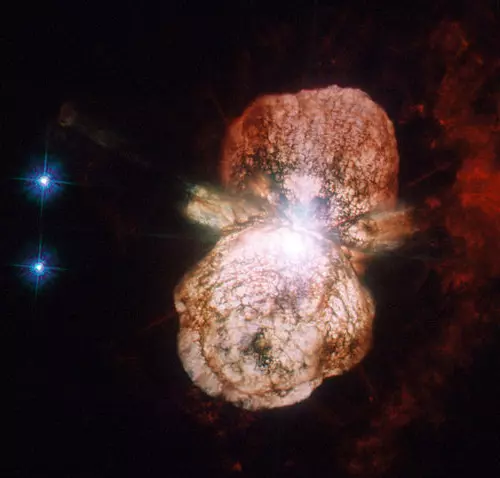
Eta Carinae and the Homunculus Nebula, credit: ESA/Hubble & NASA (CC BY 4.0)
Yellow hypergiants
Yellow hypergiants are exceptionally massive, luminous, and unstable yellow supergiants of spectral types from A to K. They are some of the most visually luminous stars known, with absolute magnitudes of about -9. Most of these stars are believed to evolve from post-red supergiants, stars that have expelled a good portion of their outer layers and are in the process of evolving into blue supergiants and Wolf-Rayet stars.
Yellow hypergiants have extended atmospheres and have lost up to half of their initial mass. Their initial masses are in the range from about 20 to 60 solar masses. Their temperatures are between 4,000 K for type A0 stars and 8,000 K for class K2 stars. The luminosities of yellow hypergiants are between 200,000 and 600,000 times that of the Sun. These stars are exceptionally rare; only 17 are known in the Milky Way, six of which are found in the Ara Cluster (Westerlund 1).
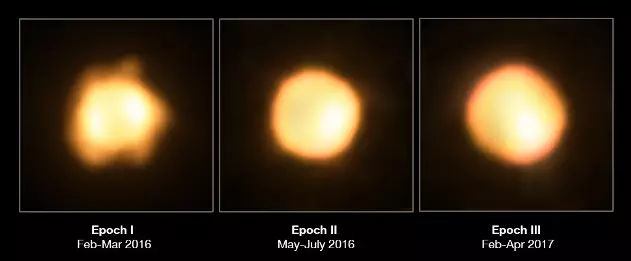
It may not look like much, but this blob shows a remarkable star named V766 Centauri (HR 5171) and its close companion. It was first studied and classified a few years ago by researchers using ESO’s Very Large Telescope Interferometer (VLTI) when it was found to be something known as a yellow hypergiant, a massive and luminous type of star that is extremely rare — and extremely big! Measuring over 1400 times the diameter of the Sun, V766 Cen was not only the largest star of its type ever discovered, but also one of the ten largest stars ever found. Credit: ESO/M. Wittkowski (ESO) (CC BY 2.0)
Red hypergiants
Red hypergiants are the most extended and unstable red supergiant stars. Even though hypergiant spectral classifications are seldom used, the term is occasionally used for red supergiants with the most exceptional stellar parameters. These include the stars VY Canis Majoris and NML Cygni.

If placed in the middle of our solar system, the star VY Canis Majoris would engulf all the planets out to Saturn’s orbit. This monster, appropriately called a red hypergiant, is as bright as 300,000 Suns. Yet it is so far away that, 200 years ago, it could be seen only as a faint star in the winter constellation of the Great Dog. Since then, it has faded and is no longer visible to the unaided eye. Astronomers used the NASA/ESA Hubble Space Telescope to get a close-up look at the star and discovered the reason for the dimming. The star is expelling huge clouds of dust in the final stages of its life. Eventually, the bloated star may go out as a supernova, or may simply collapse and form a black hole. This zoom into VY Canis Majoris is a combination of Hubble imaging and an artist’s impression. The left panel is a multicolor Hubble image of the huge nebula of material cast off by the hypergiant star. This nebula is approximately 300 billion kilometres across. The middle panel is a close-up Hubble view of the region around the star. This image reveals close-in knots, arcs, and filaments of material ejected from the star as it goes through its process of casting off material into space. VY Canis Majoris is not seen in this view, but the tiny red square marks the location of the hypergiant, and represents the diameter of the solar system out to the orbit of Neptune, which is 5.5 billion miles across. The final panel is an artist’s impression of the hypergiant star with vast convection cells and undergoing dramatic ejections. VY Canis Majoris is so large that if it replaced the Sun, the star would extend for hundreds of millions of miles, to between the orbits of Jupiter and Saturn. Credits: NASA, ESA, and R. Humphreys (University of Minnesota), and J. Olmsted (STScI) (CC BY 2.0)
8. Stellar remnants
When they reach the end of their life cycle, stars can become white dwarfs, neutron stars or black holes. Their ultimate fate is determined by their initial mass. The life cycle of stars can also be affected by the stars’ environment, i.e. by whether they are single or binary stars.
Stellar remnants can be:
- White dwarfs
- Neutron stars
- Black dwarfs
- Black holes
White dwarfs
White dwarfs are remnants of low to intermediate mass stars that expelled their outer layers when they reached the end of their life cycle. They are stellar cores consisting mostly of electron-degenerate matter. White dwarfs are the final stage of evolution for stars that are not massive enough to become neutron stars or black holes. These stars constitute more than 97% stars in our galaxy.
White dwarfs are very dense objects. The nearest known white dwarf, Sirius B, has a mass 102% of the Sun packed into a diameter almost that of the Earth. Popularly known as the Pup (because it is the companion to the Dog Star), Sirius B was discovered by the German astronomer Friedrich Wilhelm Bessel in 1844. It lies 8.6 light years away.
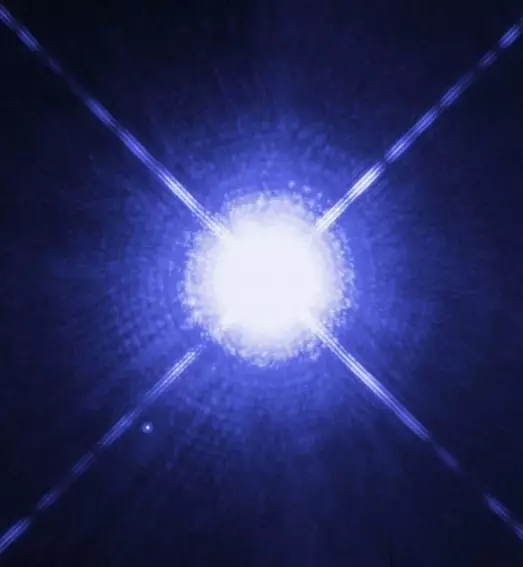
This Hubble Space Telescope image shows Sirius A, the brightest star in our nighttime sky, along with its faint, tiny stellar companion, Sirius B. Astronomers overexposed the image of Sirius A [at centre] so that the dim Sirius B [tiny dot at lower left] could be seen. The cross-shaped diffraction spikes and concentric rings around A*, and the small ring around Sirius B, are artifacts produced within the telescope’s imaging system. The two stars revolve around each other every 50 years. Sirius A, only 8.6 light-years from Earth, is the fifth closest star system known. The image was taken with Hubble’s Wide Field Planetary Camera 2. Image: NASA, ESA, H. Bond (STScI), and M. Barstow (University of Leicester)
Neutron stars
Neutron stars are the remnant cores of supergiants with masses between 10 and 25 times that of the Sun, that ended their lives as supernovae. They are even smaller and denser than white dwarfs. Except for black holes, neutron stars are the smallest and densest known type of stellar objects. They pack a mass of about 1.4 solar masses into a radius of about 10 kilometers (6 miles). The Milky Way is believed to contain about a billion neutron stars.
Neutron stars are products of supernova events combined with gravitational collapse. These events leave a condensed core much smaller than a white dwarf. Neutron stars are believed to be composed almost entirely of neutrons, subatomic particles with a neutral charge. They have gravitational fields about 200 billion times that of Earth at their surfaces and spin at up to several hundred times per second. Some emit beams of electromagnetic radiation out of their magnetic poles and are known as pulsars. The fastest spinning pulsar known, PSR J1748-2446ad, spins 716 times per second. It lies within the globular cluster Terzan 5 in Sagittarius.
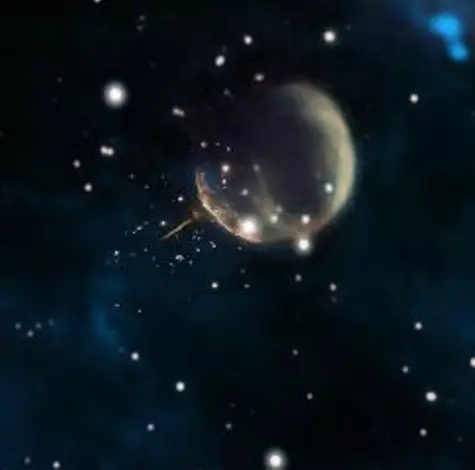
Observations using the Very Large Array (orange) reveal the needle-like trail of pulsar J0002+6216 outside the shell of its supernova remnant, shown in image from the Canadian Galactic Plane Survey. The pulsar escaped the remnant some 5,000 years after the supernova event. Credit: Composite by Jayanne English, University of Manitoba; F. Schinzel et al.; NRAO/AUI/NSF; DRAO/Canadian Galactic Plane Survey; and NASA/IRAS. (CC BY 3.0)
Black dwarfs
Black dwarfs are white dwarfs that have cooled down to the point where they do not emit any significant light or heat. Since white dwarfs would take much longer than 13.77 billion years (the age of the universe) to reach this stage, black dwarfs have not yet been observed and are theoretical objects. Some of the coolest white dwarfs detected have temperatures below 3,900 K and are believed to be 11-12 billion years old.
The term “black dwarf” is also applied to theoretical cooled brown dwarfs, substellar objects that are not massive enough to burn hydrogen.
Black holes
Black holes are defined as dense, massive regions of spacetime with such intense gravity that nothing, including light, can escape from them. Stellar-mass black holes form when very massive stars collapse in supernova events at the end of their lives. They pack a mass 10 times that of the Sun into a radius of 30 kilometers (18.6 miles). They typically have masses in the range from about 5 to several tens of solar masses. Stellar black holes are very difficult to detect but taking into account the number of stars that are massive enough to produce them, scientists believe that there may be between 10 million and a billion such objects in our galaxy.
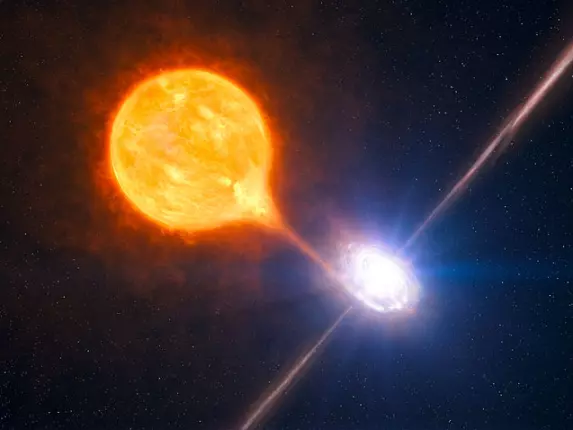
Combining observations done with ESO’s Very Large Telescope and NASA’s Chandra X-ray telescope, astronomers have uncovered the most powerful pair of jets ever seen from a stellar black hole in the spiral galaxy NGC 7793. The black hole blows a huge bubble of hot gas, 1000 light-years across or twice as large and tens of times more powerful than the other such microquasars. The stellar black hole belongs to a binary system as pictured in this artist’s impression. Credit: ESO/L. Calçada/M.Kornmesser (CC BY 4.0)
Additional classes
Wolf-Rayet stars
Wolf-Rayet stars are rare and exceptionally luminous stars with surface temperatures in the range from 20,000 K to about 210,000 K. Only about 500 of these stars have been discovered in the Milky Way. They are a stage in the evolution of highly massive stars. Wolf-Rayet stars are believed to evolve from the most massive red and blue supergiants or directly from the main sequence.
Classic Wolf-Rayet stars are highly evolved and massive stars that have depleted their outer hydrogen and show a surface enhancement of heavy elements. They have strong stellar winds and have luminosities hundreds of thousands of times that of the Sun. Many are surrounded by Wolf-Rayet nebulae. By the time they appear as WR stars, they have lost at least half of their initial mass.
Some Wolf-Rayet stars still show hydrogen lines in their spectra and are still fusing hydrogen at their cores. Their luminosities tend to be more than a million times that of the Sun.
Another group of stars with spectra of Wolf-Rayet stars are the central stars of planetary nebulae that have expelled their outer layers to reveal a carbon-oxygen core. Their bolometric luminosities tend to be thousands of times that of the Sun.
The brightest Wolf-Rayet star in the sky is Regor (Gamma Velorum), which is also the nearest Wolf-Rayet star to the Sun. It shines at magnitude 1.83 from a distance of 1,095 light years. It has a mass about 9 times that of the Sun and a luminosity of 170,000 Suns. Its initial mass is estimated at 40 solar masses.
Wolf-Rayet stars are some of the most luminous stars known. The current record holders – R136a1, R136a2 and BAT99-98 in the Tarantula Nebula in the Large Magellanic Cloud (LMC) – are all Wolf-Rayet stars. They have luminosities of 6,166,000 L☉ (R136a1), 5,623,000 L☉ (R136a2), and 5,000,000 L☉ (BAT99-98). They are also among the most massive stars known, with masses of 184 – 260 M☉, 154 – 210 M☉, and 226 M☉ respectively.
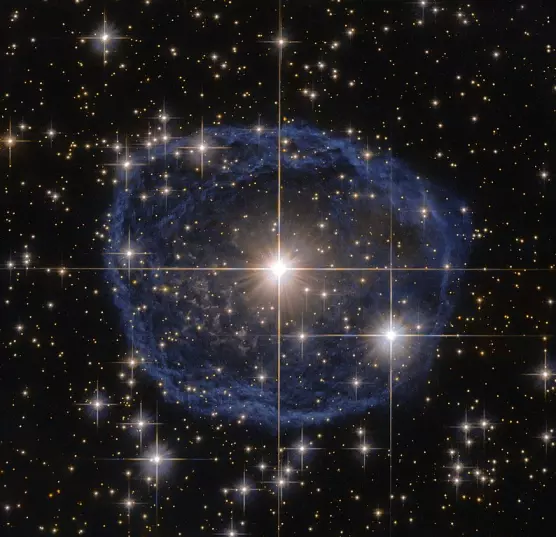
Sparkling at the centre of this beautiful NASA/ESA Hubble Space Telescope image is a Wolf–Rayet star known as WR 31a, located about 30,000 light-years away in the constellation of Carina (the Keel). The distinctive blue bubble appearing to encircle WR 31a, and its uncatalogued stellar sidekick, is a Wolf–Rayet nebula — an interstellar cloud of dust, hydrogen, helium and other gases. Created when speedy stellar winds interact with the outer layers of hydrogen ejected by Wolf–Rayet stars, these nebulae are frequently ring-shaped or spherical. The bubble — estimated to have formed around 20 000 years ago — is expanding at a rate of around 220,000 kilometres per hour! Image: ESA/Hubble & NASA Acknowledgement: Judy Schmidt (CC BY-SA 4.0)
Subdwarfs
Subdwarfs are stars with luminosity 1.5 to 2 magnitudes lower than that of main sequence stars of the same spectral class. They are found just below the main sequence on the Hertzsprung-Russell diagram. These are mostly old stars, usually found in the Milky Way’s halo.
Cool subdwarfs with the stellar classification G, K or M fuse hydrogen in their cores like regular main sequence stars, but are much less luminous because they have low metal content. Kapteyn’s Star, a red subdwarf of the spectral type M1, is the nearest halo star to the Sun. It lies only 12.83 light years away. It has a diameter 30% that of the Sun, but only 1.2% of the Sun’s luminosity. It has an estimated age of about 11.5 billion years.
Groombridge 1830 (Argelander’s Star) is another example of this class. It is a yellow subdwarf of the spectral type G8, located 29.9 light years away. It has a radius of 0.681 R☉ and a luminosity of 0.212 L☉. Its estimated age is between 4.7 and 5.3 billion years.
Hot subdwarfs with the stellar classification O and B are a completely different class. They represent a late evolutionary stage for red giant stars that lose their outer layers prematurely, before they start to fuse helium in their cores. This typically happens in binary star systems.
Brown dwarfs
If an object is not massive enough to sustain nuclear fusion of hydrogen in its core, but is able to fuse deuterium (heavy hydrogen), it is defined as a brown dwarf. Brown dwarfs have masses of less than about 0.08 solar masses, but are more massive than the most massive planets. Typically, they have a mass 13 to 80 times that of Jupiter. Those with masses of more than 65 Jupiter masses are also able to fuse lithium.
Brown dwarfs are classified as substellar objects. Their temperature declines over time and they pass through later spectral types over the course of their evolutionary cycle.
The nearest brown dwarfs are found in the Luhman 16 system, the third closest system to the Sun. The binary brown-dwarf system lies only 6.516 light years away in the constellation Vela. The components, Luhman 16A and 16B, have masses of 0.032 and 0.027 M☉ (33.5 and 28.6 MJup) and radii of about 0.85 and 1.04 RJup. With effective temperatures of 1,350 and 1,210 K, they shine with only 0.0000219 and 0.0000209 L☉. They are separated by 1.5 arcseconds on the sky, corresponding to a physical distance of 3 astronomical units (Earth – Sun distances). The system has an estimated age of 600 – 800 million years.
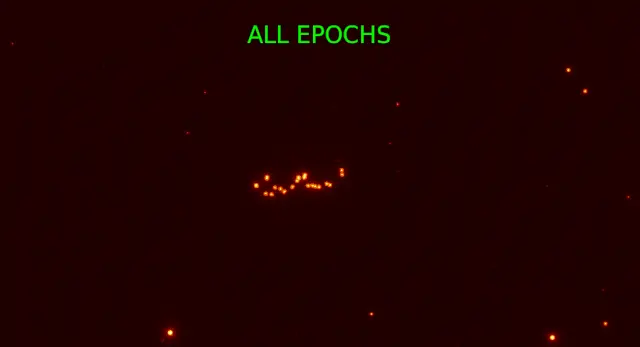
Luhman 16 as seen by the Hubble Space Telescope in 12 epochs. The astronomers using Hubble to study Luhman 16AB were not only interested in the waltz of the two brown dwarfs, but were also searching for a third, invisible, dancing partner. Earlier observations with ESO’s Very Large Telescope indicated the presence of an exoplanet in the system. The team wanted to verify this claim by analysing the movement of the brown dwarfs in great detail over a long period of time, but the Hubble data showed that the two dwarfs are indeed dancing alone, unperturbed by a massive planetary companion. Credit: ESA/Hubble & NASA, L. Bedin et al. (CC BY 4.0)